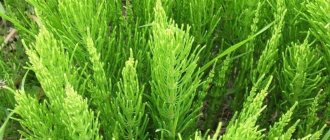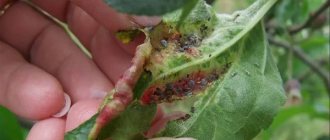Author: Natalya Category: Plant Pests Published: December 25, 2016Republished: February 26, 2019Last edits: October 28, 2020
The mole cricket beetle (lat. Gryllotalpidae) belongs to the family of large burrowing insects of the order Orthoptera, which includes more than 110 species. The most common pest in our gardens and vegetable gardens is the common mole cricket (lat. Gryllotalpidae gryllotalpa), or cabbage mole cricket, which in Europe is not found only in Finland and Norway, but also lives in Asia, North Africa, Transcaucasia and Kazakhstan, preferring sandy, heated the sun of the soil. The mole cricket insect lives primarily underground, coming to the surface only at night, and hibernates at a depth of two or more meters or in warm compost heaps. The pest feeds not only on root vegetables and earthworms - its danger lies in the fact that it is omnivorous. In addition to beets, carrots and potatoes, the victims of the mole cricket can be cucumbers, onions, lettuce, cabbage, strawberries, corn, barley, oats, rye, legumes, melons and flower crops.
Medvedka: description and damage caused
Mole crickets are large burrowing insects that form a separate family. They are 5-9 cm long and live in burrows they dig. The appearance of the pest is very characteristic; it is difficult to confuse it with any other insect.
Medvedka
The fight against mole crickets on the site is, first of all, a strategic fight. Leading a secretive lifestyle, the insect always finds options on how to survive in the conditions of certain countermeasures, therefore, in order to defeat this pest, just one method of exterminating it is not enough; it is necessary to use several.
The insect's forelimbs are seriously modified and adapted for digging. The chest shell is thick and very durable. In case of danger, the insect's head is completely retracted under it.
The abdomen is long, approximately 2-3 times larger than the cephalothorax, however, it is practically not protected by a chitinous layer. The body color of a mole cricket is almost always the same – it is dark brown on top and light brown or olive underneath.
A mole cricket protecting its clutch
The insect is a pest of many crops. All tuberous, root, berry and fruit crops are included in the list of the mole cricket’s diet. If there are no root crops, the pest moves on to rhizomes and bulbs.
In particularly serious cases, it even damages the root system of not only fruit trees, but also non-fruit trees.
Mole cricket larva
Signs of the appearance of a mole cricket on the site are its passages, burrows and loud evening chirping, reminiscent of the sounds made by crickets. Which, however, is not surprising, the families of Medvedkov and Real Crickets are very close relatives.
Mole cricket moves after precipitation
How to get rid of mole crickets on your property: the most effective ways
Folk methods and remedies will help you cope with pests in your summer cottage. They are effective, affordable and safe.
The following methods will help you remove pests from your dacha:
- digging up the area - this destroys the nests and disrupts the vital activity of parasites;
- creation of artificial barriers;
- exposure to substances with a pungent odor;
- etching, flooding.
Barriers for insects
A simple but effective way to protect young plants from mole crickets is to create barriers. To do this, cut old plastic bottles into rings and place them around the plant. They should cover the roots and rise 5 cm above the ground. This primitive method will protect the root system and shoots.
Nylon stockings can save a young plant . They will reliably protect the root system of the plant without disturbing the process of its development. Place an old nylon stocking over the root before planting to protect it from mole crickets and other pests.
Homemade trap
Effective home remedies in the fight against earthen cancer are traps - yeast/beer, water, shadow or manure. They differ in the way they are organized, but they are all based on the preferences and activities of pests.
According to reviews from experienced summer residents, traps have a very effective effect, so let’s take a closer look at each of the options.
Traps are an effective way to control cabbage weed. The bait will lure the pests out of their holes, after which they will fall into a trap from which they will not be able to escape.
Shadow
During the day, mole crickets prefer to hide in secluded corners, under leaves or stones. To attract them, place scraps of dark fabric on the site in sunny places. Raise the shade traps daily and destroy any pests found.
Yeast/beer
Bears love beer. Dig several bottles or narrow jars with the remains of the intoxicating drink into the ground. Leave the necks open. Pests will crawl into containers, attracted by the smell of the bait, and will not be able to get out.
We offer a video, after watching which you will be convinced of the effectiveness of a similar trap:
Water/sweet
A water trap has the same operating principle, but instead of beer, use clean water, and to attract insects, lubricate the neck of a bottle or jar with honey.
Manure/compost
manure is effective .
The procedure for using it is quite simple:
- In the fall, dig several holes in the garden, up to half a meter deep.
- Fill the holes with manure mixed with hay.
- The mole crickets will crawl to the hot spots to set up a home for the winter.
- After the first frost, dig out traps and scatter manure with insects over the surface of the ground.
- Frosts will destroy pests.
how an experienced gardener catches pests from a compost pit in the following video:
Other ways to kill and scare away mole crickets
Having identified traces of pests in the area, try to lure the mole cricket outside . This can be done using a kerosene-based solution:
- Dilute 100 g of kerosene in a bucket of water.
- Pour the resulting solution into the mole crickets' passages at intervals of a couple of hours.
- Destroy the emerging insect.
The disadvantage of this method is the inability to detect all underground passages of pests, so it does not guarantee one hundred percent elimination of them.
Another way to expel a mole cricket from a hole:
- Grate 50 g of laundry soap or take 20 g of washing powder.
- Prepare a soap solution in 10 liters of water.
- Pour the resulting product into the pests' passages, wait until they crawl out and kill them.
A soap solution based on laundry soap or washing powder will help lure out the pest. Just pour liquid into the insects' passages, and in a couple of minutes they will crawl out of their holes
You can lure the mole cricket with sunflower oil :
- Pour 1 teaspoon of oil into the mink.
- Pour a large amount of water into the passages - 1 bucket.
- The oil will moisten the hairs that cover the insect's body and block the pest's respiratory tract.
- This condition will cause discomfort and the insect will crawl out, where it should be waited and destroyed.
Crushed eggshells . Combine the resulting powder with sunflower oil in equal proportions and distribute evenly over the area during digging (in autumn or spring). You can also pour eggshells into the holes when planting seedlings or potatoes.
As a poisonous bait, also use steamed oats, wheat or corn, sprinkled with Aldrin (50 g of powder per 1 kg of grain).
To get rid of mole crickets in the garden forever (or at least for a long time), use an integrated approach - baits, traps and other folk remedies
Ultrasonic repellers
Modern developments - ultrasonic repellers - will help drive pests away from the site. The devices emit signals that negatively affect the condition of insects and even some animals. With this impact, the mole cricket experiences discomfort, forcing it to leave the area.
To repel pests, devices such as “Riddex”, “Grad”, “Post Reject”, “Typhoon”, etc. are used. Before purchasing, consult with a specialist to choose a device that will not harm pets.
Application of chemistry
Sealing mole cricket burrows with cotton wool
The chemical industry produces a fairly large number of drugs used to kill mole crickets.
Almost all of them are broad-spectrum insecticides that can also destroy the following species:
- larvae of May beetles and bronze beetles
- wireworm larvae and adults
- black garden ants (breeding aphids and mealybugs)
A description of the drugs and the features of their use is given in the table:
| A drug | Active substance | How to use |
| Medvetox | Spectracid 25E | It is a red granular powder. Harmless to plants and many other species of earth animals, in particular earthworms. Placed between rows in long furrows up to 5 cm deep. Validity period is about 15 days. The action begins a few hours after application. |
| Anti-Medvedka | Imidacloprid | Large and small white granules. Consumption - no more than 20 g per 1 hundred square meters. Placed on the surface between the beds during planting. |
| Medvecid | Imidacloprid | Small purple granules. They are located in furrows no more than 3 cm deep between rows. The distance between the granules is 50-100 cm. Consumption is 10g per 1 sq. m. |
Rembek | Imidacloprid and chlorpyrifos | Presents a malfunctioning strong-smelling bait. Consumption - no more than 25 g per 1 hundred square meters. Baits are placed in and around holes. |
| Boverin | Beauveria bassiana spores | A suspension is made from the substance, which is applied to plants and around mole cricket burrows. The spores of the fungus, falling on the skin of an insect, begin to germinate inside its body, which leads to death within a few days. Repeated treatment is carried out after 1-2 weeks. |
| Phenaxin-plus | Phosphothion | It is a strong-smelling white-yellow granule. Their laying is carried out at the stage of sowing seeds. Repeated treatment - 3 weeks after sowing (duration of the drug); in this case, the granules are simply placed near the stems. |
Any of the listed drugs (except Boverin) can be used in a mixture with edible bait - oatmeal, buckwheat or pearl barley porridge. Sunflower oil is also added to the bait. In the evening, the resulting mixture is laid out near the bear's burrows in the amount of 10-15 g per hole.
In addition, to combat mole crickets, acetylene is used, which is poisonous for the insect. To do this, 5 g of calcium carbide is placed in each hole and all holes are sealed with cotton wool or soft cloth, covered with earth on top.
When the substance reacts with water (in the form of rain or irrigation water), it decomposes into acetylene, which fills the mole cricket's burrows and passages. The gas quickly kills the insect.
Kerosene can also be used against mole crickets. However, this comes with some problems: due to the relatively high toxicity of the drug, it is not recommended for use in large quantities. You can fill no more than 1-2 holes on the site with kerosene; Up to 50 ml of substance is consumed for each hole.
What does a bear look like: photo
An adult mole cricket is impressive in size for an insect. With an abundance of food, it can reach 5-6 cm in length. The front legs resemble short, thickened claws, only they are not forked, like a crayfish, but have 4 powerful teeth. She uses her paws like shovels to dig underground passages. There are 2 more pairs of paws on the abdomen. The hind ones are the longest, like those of a grasshopper.
The hard, chitinous dorsal covering of the body of an adult is dark brown in color and appears shiny due to numerous golden hairs. The mole cricket has a wide head and a long (almost 3 times longer than the head) abdomen. The head contains strong jaws, tentacles, large eyes and long whiskers. Under the knees of the front legs in a deep fold are the ears.
What does a bear look like (video)
The wings of the mole cricket are well developed; when folded, they appear to be bent downwards in cords and protrude from under the short elytra. Thanks to its wings, it can fly quite long distances. Lives underground, but at the same time, not only flies well, but also runs fast.
The mole cricket overwinters in compost heaps and in the ground, at a depth of 1 m; the larvae of the first year of life in winter do not fall lower than 20-25 cm. When the soil warms up to 12-15 ° C, the insect comes out of hibernation. Mating of insects occurs in the spring. Offspring will appear in warm weather in summer. Each nest can contain several clutches. Each clutch contains from 50 to 400 eggs. From oval yellowish-gray 2 mm eggs hatch wingless larvae, which in appearance are similar to gray six-legged spiders.
Mole cricket masonry
For the first 20 days of life, the larvae live in the clutch, and then crawl into burrows, make new passages and begin to actively feed on roots, fruits and seeds. When the nest is torn apart, it is clear that the grown larvae are very active, run fast, and can even jump. The age of the larvae is divided into several stages of molting: the youngest are 15 mm in length, the larvae of the 4th stage already have the rudiments of wings, the larvae molt up to 10 times. The larvae reach adult size only the following year. The full development cycle of the pest lasts 2 years.
Repellent methods
Folk method of struggle
The mole cricket, like all insects, is able to distinguish odors well. There are odors that are both pleasant and unpleasant for insects. The list of the latter is quite extensive - it includes both the smells of certain substances and the smells of certain plants.
Therefore, to avoid the appearance of an uninvited insect, it is recommended to use the following methods:
1 In the spaces between the rows, as well as along the perimeter of the site, you can plant plants that are “unpleasant”
- calendula
- marigold
- chrysanthemums
2 To protect potato crops from insects, after flowering, you need to place branches of coniferous plants between the rows:
- fir
- ate
- pine trees
Mulching with pine needles between rows
3 Make stakes up to 40 cm long from freshly cut aspen or alder branches (at least 30 mm thick). They must be buried at a distance of at least 25 cm at a distance of no more than 1.5 m from each other. In this case, the bark should remain on the stakes. The stakes should be renewed as they dry out.
4 It is recommended to fill the mole cricket’s passages with a solution of onion peels
5 When planting plants, it is recommended to add a peeled clove of garlic under each plant.
6 Instead of garlic, you can put small fish (not salted, of course) under each plant.
7 Greenhouses should be fenced around the perimeter with furrows 5-10 cm deep, into which pour naphthalene or sand moistened with kerosene
8 For root plants (beets, carrots, parsley, etc.), it is recommended that the first watering be done with a solution of iodine in water (10 drops of iodine are dissolved in 5 liters of water)
What else repels mole crickets?
- She doesn't like the smell of rotten fish that is dug under the roots of seedlings.
- Water, to which a few drops of birch tar have been added, is used both when planting plants in a permanent place of cultivation, and for spraying on the leaves. For 5 liters of water use 5 drops of tar.
- Seeds of the black root flower, planted in the passages and burrows of a mole cricket, will force it to crawl out.
Biological methods
The mole cricket has many natural enemies. First of all, these are birds. The greatest damage to the population is caused by rooks, crows, starlings and even ordinary chickens.
Hoopoe catching a mole cricket
It is recommended to let the latter out into the garden from time to time. Naturally, this needs to be done at a time when the chickens themselves cannot harm the crops; for example, before the beginning of periods of active growth of young plants, fruiting, harvesting, etc. Chickens are able to perfectly find mole crickets and their larvae and destroy them.
In addition, hedgehogs, lizards, shrews, moles and ants are involved in the destruction of mole crickets. Attracting, for example, a hedgehog to your garden is very simple - just place a saucer of milk in the garden every evening.
With birds, everything is also relatively simple - birdhouses or nest boxes on the site will significantly improve the situation with any harmful insects, including mole crickets.
There is also a highly specialized enemy of the mole cricket – the Larra anathema wasp. This type of wasp lays eggs exclusively in mole crickets, where their development occurs. After the larva matures, it leaves the host, who soon dies.
Larra anathema wasp, a natural enemy of the mole cricket
This insect does not pose any harm to humans, plants and other inhabitants of the garden, therefore, if you encounter this wasp, there is no need to destroy it. The wasp is quite widespread in the south of the European part of Russia, in the Krasnodar Territory, as well as in Ukraine, Moldova, and Georgia.
If the issue of counteracting mole crickets is very pressing, you can also try to use wasps to combat them. Legumes are used to attract wasps. larra” is best attracted to a plant called “partridge pea”.
How to detect presence
Before destroying a harmful insect, it is necessary to accurately determine its presence in the garden. This can be done based on characteristic signs that are visible upon careful inspection of the territory.
The main signs of the appearance of a mole cricket:
- a constant increase in the number of wilted plants;
- small mounds on the beds;
- small holes in the ground;
- eggs or larvae (can be found while digging up soil or planting plants);
- characteristic sound at night (resembles the chirping of a grasshopper).
Prevention of occurrence
A typical insect light trap used to control mole crickets
To protect the area from the appearance of unwanted guests in the form of mole crickets, a number of measures should be taken. Most of them are in the nature of general recommendations carried out when counteracting various pests.
Such measures include:
1 Planting the repellent plants described earlier on the site
2 Digging of areas along the perimeter with furrows with naphthalene or special means Medvetsid
3 Systematic inspection of all types of soil and fertilizers brought to the site (manure, humus, black soil, sand, etc.) to search for mole crickets, their eggs and larvae. Approximately a third of the cases of pest penetration into plots occur with imported soil material
4 Regular weeding and loosening of the soil. Weed removal
5 During the mole cricket’s flight (mid-to-late May), use specialized light traps that are suspended above containers (you can use a regular basin) with a water-kerosene composition. Insects, flying towards the light, stumble upon a trap and fall into a basin, where a layer of kerosene located above the water envelops their bodies, causing suffocation and death
6 Since the mole cricket lives exclusively in acidic soils, it is recommended to carry out annual deacidification of the site by adding dolomite flour or lime to the soil.
At the same time, it must be said right away that some methods of preventing the appearance of pests are not applicable to mole crickets. For example, burying metal mesh around the perimeter of the site, which is very effective against moles, will not have any effect on mole crickets.
Firstly, mole crickets are somewhat smaller than moles, and secondly, unlike moles, they can move both on the ground and in the air.
Reviews
I make bait from root vegetables. In the spring, I plant last year’s carrots or beets in the ground, while scratching the surface skin to increase the smell emanating from the vegetable. When there is practically no greenery around, mole crickets crawl to the carrots to feed. And I dig poisonous porridge around the plant. So she dies.
Svetlana, 34 years old, Volgograd
I make ultrasonic repellers myself. I drive pieces of metal rods into the ground and put empty tin cans with a capacity of at least 0.5 liters on them so that they do not fly off in the wind. But they rattle a lot in the wind. That's why the mole crickets scatter. In any case, the plants next to the scarecrows are intact.
Dmitry, 49 years old, Krasnodar
Natalia
Author
Ask a Question
Fighting mole crickets is quite a tedious task; for many, the very sight of insects is unpleasant. But there's no escape. If you have already planted plants in the garden, then it is necessary that by the fall the harvest that you were counting on when planting still grows. Therefore, we arm ourselves with folk remedies, add chemicals to them, and the harvest is guaranteed, and the pest will be exterminated until next year. Health to you and your loved ones!
Traps
Sometimes gardeners (and fishermen) catch mole crickets by hand. It's easier to do this with traps. They can even be piles of manure laid out on the site in early May. A month later, manure with laid eggs is scattered to destroy both adult insects and their larvae. Pests also get into glass jars dug level with the soil. They are filled two-thirds with water. Another option: jars of potato peelings are dug in between the rows, just below the soil level, overnight. In the morning, mole crickets that end up in jars are destroyed. You can put a sheet of plywood on the damp ground so that the mole cricket can hide under it from the heat and sun. There she is found and destroyed. In the fall, they dig holes 50 cm deep, line them with any film and fill them with manure (preferably horse manure). With the onset of the first frost it is scattered on the ground. The pest freezes and dies.
Description of the insect
The shell and head of a mole cricket
Mole cricket is a major soil pest . These insects appeared on Earth before humans. This is confirmed by the found remains of the Cretaceous period.
The insect is popularly called earthen crayfish because of its appearance. On average, the length of an adult is 5–8 cm, but there are giants up to 10–15 cm in size. The mole cricket’s abdomen is soft, long, spindle-shaped with a diameter of up to 1 cm. It is colored light brown or olive. The chest is protected by a powerful shiny carapace of dark brown or brown color. In case of danger, the insect's head can partially hide under the hard chest shell.
The pest has 2 large compound eyes, long mustaches and strong jaws for gnawing stems, roots, destroying tubers, bulbs and root crops. With its front flat and jagged limbs, resembling claws, the mole cricket digs passages and holes in the soil.
The pest is shy, rarely comes to the surface, mainly at night, and during the day prefers an underground lifestyle . The mole cricket can swim and fly. The insect can rise to a height of 0.5–5 m, some species cover greater distances - up to 8 km. To do this, the adult mole cricket has shortened elytra, under which are the hind wings, folded into flagella. Moves in the dark, only at high air temperatures. When it is cold, the insect's muscles do not warm up to the required temperature.
There are 3 types of pests common in our country. The common mole cricket is found everywhere in the European part of the country; the single-spined species lives in the Volga region, and the eastern species lives in the Far East.
How to remove mole crickets from the garden: basic control methods
The fight must begin in early spring.
When the soil warms up well, active life of insects begins at this time. And the peak of this activity occurs during the period of planting root crops and seedlings.
What would I like to advise gardeners if pests have attacked your plot. It's better to use chemicals to start with. Although this is not a very useful product for the soil, as well as for the plantings themselves. But I think that in such a situation there is no choice.
Use of drugs:
1. Select the desired composition. There are no safe chemicals. Therefore, reduce the concentration as much as possible, depending on the plants.
2. There are drugs that are used before planting.
3. Half a month after planting, the properties of the chemicals will decrease. This means that the mole cricket will again be able to damage the plants. To do this, you need to acquire poisonous traps in advance.
How to remove mole crickets from the garden using drugs;
- "Medvetoks";
- "Gromoboy";
- "Vafatox";
- "Regent". The split peas are boiled and mixed with the preparation. Before planting potatoes, grooves are made and bait is laid. Then it is covered with earth.
Before planting, seed potatoes need to be soaked in the Prestige preparation. The Colorado potato beetle also does not tolerate this poison.
The drug "Bi-2" repels pests with its smell. And if it gets inside an insect, it dies. Ultrasonic repellers are also used. The sound effect of these devices negatively affects insects. After which they, feeling danger, leave the territory. It is important to note that the fight must be waged in agreement with the neighbors. Otherwise the pest will return.
Additional measures;
- regularly add pesticides to the soil. In this way, the number of insects will gradually be reduced;
- In the fall, before frost, be sure to plow your garden.
Mechanical removal
You can protect seedlings from mole crickets using mechanical methods. It is best to apply them in the spring, before the immediate planting of cultivated plants, or in late autumn. The second option is considered more effective, as it allows you to destroy most of the beetles.
Work order:
- In the middle or end of November, the garden is dug up.
- The upturned layers of earth will open nests in which mole crickets settle for the winter. Frosty air will quickly kill heat-loving creatures.
- After this, holes about 50 cm deep are dug in several places.
- Fresh manure is placed in them.
- The holes are buried and their location on the site is marked.
- The manure will attract the attention of large mole crickets that will want to spend the winter in it.
- After 1-2 days, they dig up the foul-smelling bait and scatter it around the garden.
- Creatures killed by the cold are collected manually.
Advice! If you add straw to the manure, you can attract many more mole crickets.
What harm does
The mole cricket is the main enemy of gardeners. This large shrew spends most of its life underground. Because of this, its presence can only be noticed after several weeks. During this time, she will have time to lay eggs and destroy a significant part of the crop.
Damage caused:
- eats the roots of onions, bell peppers, carrots, cucumbers, tomatoes, peas;
- quickly destroys the underground part of potato, strawberry and strawberry bushes;
- while digging tunnels, the mole cricket damages the roots of flowers;
- lays eggs, from which constantly hungry larvae emerge.
Destruction of mole crickets in the garden
To effectively combat such a serious garden pest, you need to “know it by sight.” I’ll tell you about the life functions of the mole cricket:
- The insect is nocturnal. At this time of day, it gets out to the surface of the earth and changes its location.
- The mole cricket loves warm, moist soil, illuminated by the sun during the day. It prefers a substrate richly fertilized with manure, in which a “greenhouse effect” occurs.
- The insect is unusually prolific. Up to 500 larvae can hatch from one clutch of eggs. In terms of appetite, they can compete with locusts.
The first sign of a pest appearing in the garden is small areas that look like mown grass. The mole cricket cuts it off with its powerful jaws - it fights against shading, which interferes with the breeding of offspring.
signs of a mole cricket in the garden
Carefully monitor the pest operating in your garden - its burrows can be confused with manholes, passages of shrews and moles. But each of these uninvited guests has its own methods of struggle. Traps, bait, erection of natural barriers and the use of ultrasonic repellers are effective against mole crickets. They successfully fight pests using folk remedies.
If these methods are powerless, they turn to chemicals and biological poisons. If the use of such drugs is unsuccessful, “heavy artillery” is needed - a sanitary service specializing in large-scale pest control. Professionals work with powerful chemicals that literally destroy all life on the site. Therefore, turning to such a drastic remedy is justified only in case of a large invasion of earthen crayfish.
Protective rings and barriers
One of the most effective methods involves installing a protective fence. It is made from a plastic bottle, the bottom and neck of which are cut off. The remaining part of the container is deepened into the ground around the shoots. The mole cricket will not be able to chew through the plastic ring or crawl under it.
Plants that repel mole crickets:
Kapusyanka does not like all smells. Gardeners often use this feature to protect their crops.
Marigold
These beautiful and pleasantly smelling flowers are an effective mole cricket repeller. The aroma coming from the buds makes them fly around the garden and look for places with more favorable conditions.
To completely protect your garden plot from harmful insects, it is enough to plant marigolds along its entire perimeter.
Chrysanthemums
To save crops from mole crickets, it is not necessary to poison or kill it. It is enough to take several dozen chrysanthemum branches and dig them into the ground. The smell will repel beetles and protect the planted plants.
Coriander
The real way to drive mole crickets out of the garden involves planting coriander. It will not only protect the area, but can also be used in cooking. The roots and seeds of coriander are used as a seasoning, and the leaves are used to decorate various dishes.
Garlic
If you do not want to poison mole crickets with chemicals, then you will have to save the seedlings using alternative methods. One of the most effective is considered to be planting garlic. Its smell repels many beetles, preventing them from spoiling the crops. If it is not possible to plant garlic, then you can lay out its husks in various parts of the garden.
Onion
It does not kill mole crickets, but effectively copes with their invasion. The principle of action of onions is the same as that of garlic. The gardener can independently choose one of two options:
- planting onions;
- laying out the husks.











